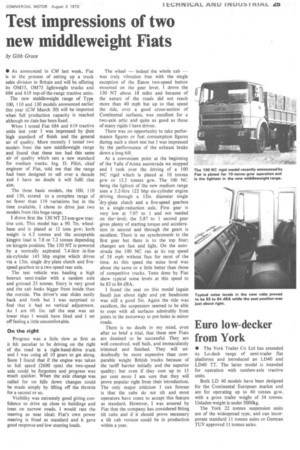Test impressions of two new middleweight Fiats
Page 27

If you've noticed an error in this article please click here to report it so we can fix it.
by Gibb Grace • As announced in CM last week, Fiat is in the process of setting up a truck sales division in Britain and will be offering its 0M55, 0M75 lightweight trucks and 684 and 619 top-of-the-range tractive units.
The new middleweight range of Type 100, 110 and 130 models announced earlier this year (CM March 30) will be imported when full production capacity is reached although no date has been fixed.
When I tested Fiat 684 and 619 tractive units last year I was impressed by their high standard of finish and the general air of quality. More recently I tested two models from the new middleweight range and found that these too had this same air of quality which sets a new standard for medium trucks. Ing. D. Filtri, chief engineer of Fiat, told me that the range had been designed to sell over a decade and I have no doubt it will fulfil that The three basic models, the 100, 110 and 130, extend to a complete range of no fewer than 119 variations but in the time available, I chose to drive just two models from this huge range.
drove first the 130 NT 23-ton-gcw tractive unit. This model has a 911 7in. wheelbase and is plated at 12 tons gvw; kerb weight is 4.2 tonnes and the acceptable kingpin load is 7.8 or 7.2 tonnes depending on kingpin position. The 130 NT is powered by a normally aspirated 7.4-litre in-line six-cylinder 145 bhp engine which drives via a 13in. single dry-plate clutch and fivespeed gearbox to a two-speed rear axle.
• The test vehicle was hauling a high boxvan semi-trailer with a tandem axle and grossed 23 tonnes. Entry is very good and the cab looks bigger from inside than the outside. The driver's seat slides easily back and forth but I was surprised to find that it had no vertical adjustment. As I am 6ft lin. tall the seat was set lower than I would have liked and I set off feeling a little uncomfortable.
On the right
Progress was a little slow at first as it felt peculiar to be driving on the right of the road in a right-hand-drive truck and I was using all 10 gears to get along. Soon I found that if the engine was taken to full speed (2600 rpm) the two-speed axle could be forgotten and progress was much quicker. When the axle change was called for on hills down changes could be made simply by lifting off the throttle for a second or so.
Visibility was extremely good giving confidence to drive up close to buildings and trees on narrow roads. I would rate the steering as near ideal; Fiat's own power steering is fitted as standard and it gave good response and low steering loads. The wheel — indeed the whole cab was truly vibration free with •the single exception of the Eaton two-speed button mounted on the gear lever. I drove the 130 NT about 18 miles and because of the nature of the roads did not reach more than 40 mph but up to that speed the ride, over a good cross-section of Continental surfaces, was excellent for a two-axle artic and quite as good as those of many rigids I have driven.
There was no opportunity to take performance figures or fuel consumption figures during such a short test but I was impressed by the performance of the exhaust brake down a long hill.
At a convenient point at the beginning of the Valle d'Aosta autostrada we stopped and I took over the driving of a 100 NC rigid which is plated at 10 tonnes gvw or 12.5 tonnes gcw. The 100 NC being the lightest of the new medium range uses a 5.2-litre 122 bhp six-cylinder engine driving through a 12in. diameter single 'dry-plate clutch and a five-speed gearbox to a single-reduction axle. First gear is very low at 7.07 to 1 and not needed on the level; the 3.87 to 1 second gear gives plenty of starting torque and acceleration in second and through the gears is excellent. There is no synchromesh to the first gear but there is to the top four; changes are fast and light. On the autostrada the 100 NC ran at its top speed of 58 mph without fuss for most of the time. At this speed the noise level was about the same or a little better than those of competitive trucks. Tests done by Fiat show typical noise levels at this speed to be 83 to 84 dBA.
I found the seat on this model (again fixed) just about right and yet headroom was still a good Sin. Again the ride was excellent, the suspension seemed to be able to cope with all surfaces admirably from joints in the motorway to pot-holes in minor roads.
There is no doubt in my mind, even after so brief a trial, that these new Fiats are destined to be successful. They are well conceived, well built, and immaculately trimmed and finished. They will undoubtedly be more expensive than comparable weight British trucks because of the tariff barrier initially and the superior quality; but even if they cost up to 15 per cent more I am sure that they will prove popular right from their introduction. The only major criticism I can foresee is that the cabs do not tilt and most operators have come to accept this feature as standard. However, I was assured by Fiat that the company has considered fitting tilt cabs and if it should prove necessary a tilt cab version could be in production within a year.
































































































